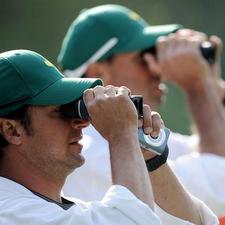Since 2006, the CGA has allowed competitors in most of its championships to use distance-measuring devices. The CWGA gave the devices the OK in the fall of 2010.
Now it’s the CJGA’s turn.
Starting this year, 14-18-year-old golfers will be permitted to use distance-only measuring devices in CJGA tournaments, as well as in the CGA and CWGA Junior Stroke Play and Junior Match Play Championships.
In other words, many of the state’s top events for junior players will feature a lot more golfers lasering the distances of their shots, and a lot fewer pacing off the yardages from sprinkler heads and the like.
“We traditionally follow the AJGA (American Junior Golf Association) lead on policy changes, and they’re allowing (distance-only range-finders) in all their events in 2013,” said Eric Wilkinson, the CGA’s director of junior competitions. “We want to stay consistent with national junior tours and other (golf organizations) around us. A lot of other state and regional junior golf associations are allowing them, and we didn’t want to be in a position where players in our events weren’t allowed to use them.”
Added Kelley Mawhinney, tournament and junior golf operations manager for the CWGA: “We wanted to be on the same page (as the AJGA). We don’t want to confuse players” with varying rules.
The AJGA allowed range-finders on a trial basis in four tournaments in 2012. Distance-measure devices are already permitted in college events, but the USGA doesn’t allow them in its national championships or its qualifiers.
Wilkinson was quick to note that the CJGA allowance applies only to 14-18-year-olds in the association’s tournaments, and not to younger players. Also, devices measuring only distance will be permitted; those that gauge such things as slope, wind speed, elevation, temperature, etc., are forbidden, even if such functions are turned off or ignored. So are the use of smart phone apps.
“It’s up to fellow competitors to police it themselves, but we’re trying to educate players in advance,” Wilkinson said. “We know we’ll get a lot of questions at our first event, so we want to be proactive.”
The first tournament in which the distance measuring devices will be allowed is the CJGA Spring Series event this weekend (April 27-28) at Walking Stick Golf Course in Pueblo.
While the increased affordability of the devices have made the Colorado associations amenable to permitting them for juniors, the organizations are still sensitive that some teenagers may not be able to afford range-finders. For that reason, distance information can be shared among players. For example, a competitor without a range-finder can get the distance to the pin from a fellow player, or can borrow such a device.
The approval of the use of such devices — which came from the CGA Junior Tournament Committee and the CWGA Rules and Tournament Committees — will affect many events, but most notably the CGA and CWGA junior state championships. Those tournaments are among the most prestigious in Colorado, with both the CGA and CWGA Junior Match Play dating back to the early 1950s, and the boys and girls Junior Stroke Play originating in the late 1970s.
Although CJGA officials discussed the possibility of the use of distance measuring devices speeding up play — especially among players with a higher handicap — Wilkinson said that wasn’t a major reason the association’s policy was changed.
Indeed, Pete Lis, who just left his job as CGA director of rules and competitions to become an LPGA Tour rules official, said he isn’t convinced that range-finders speed up play.
“At the end of the day, I don’t think it makes any difference,” Lis said recently. “I’ve seen some players pace off the yardage and shoot it too, so I think an argument can be made that it worsens pace of play. But I don’t think it makes that much difference.”


